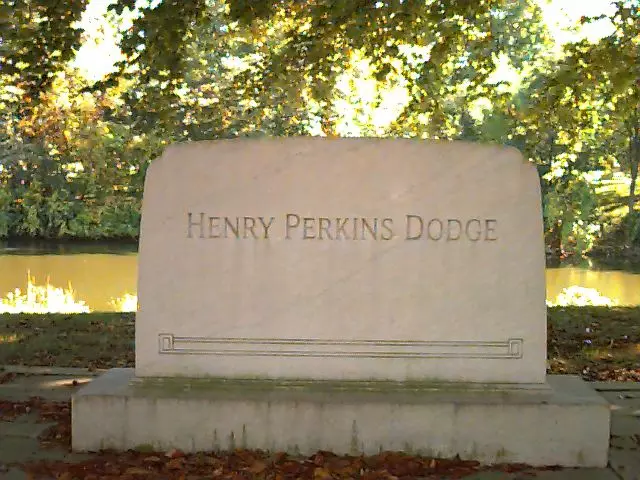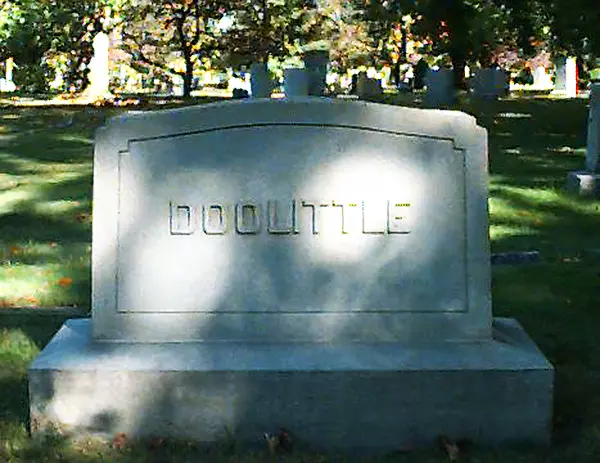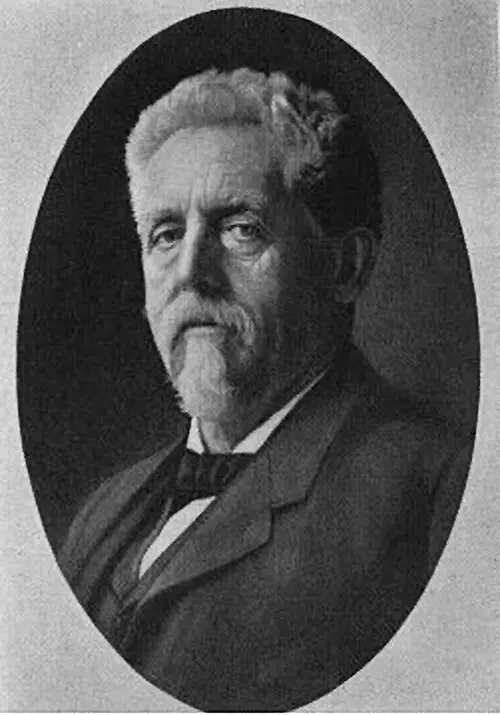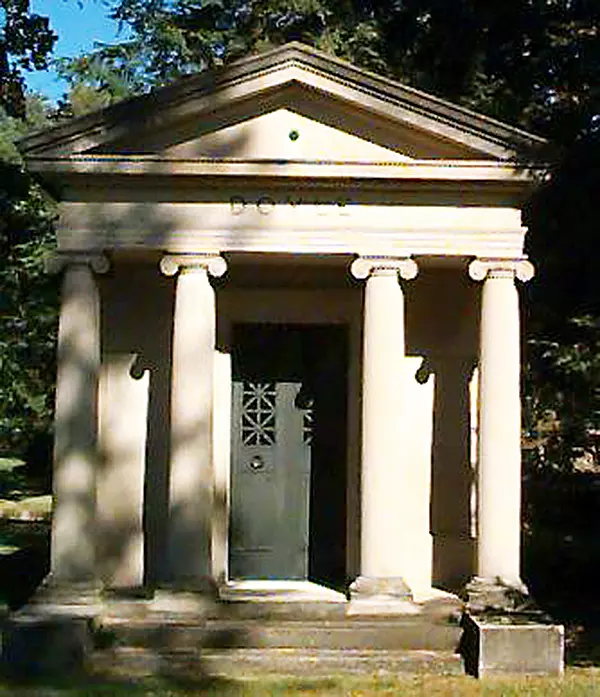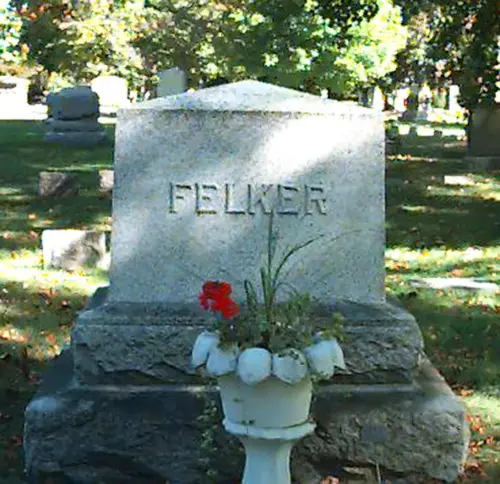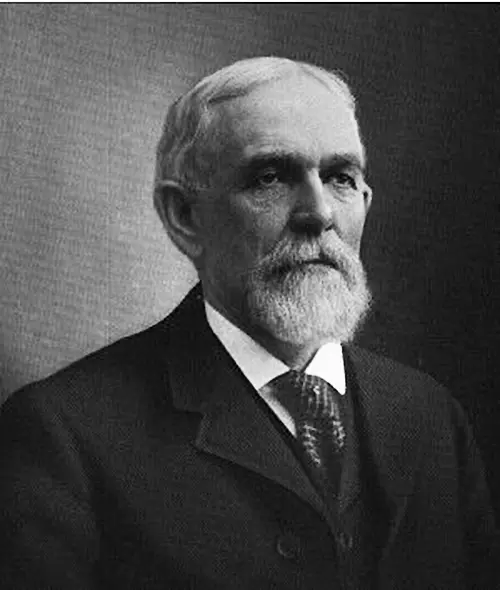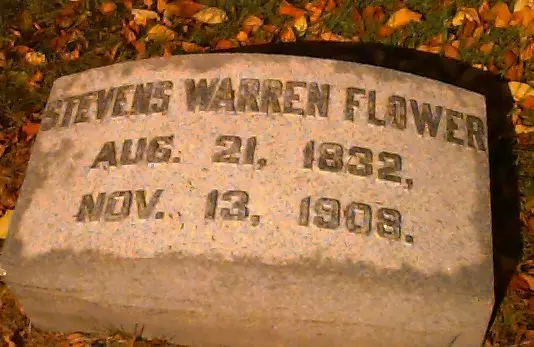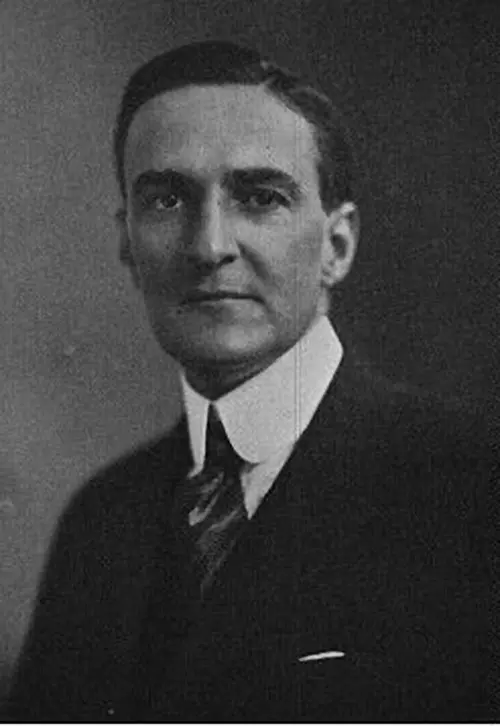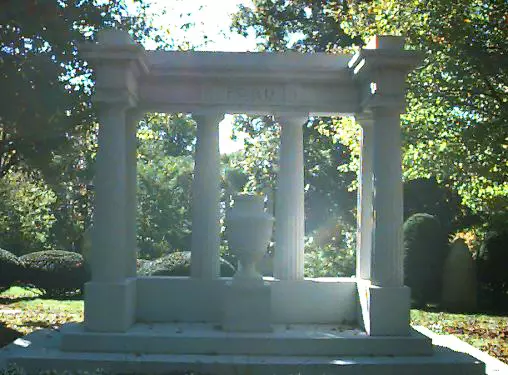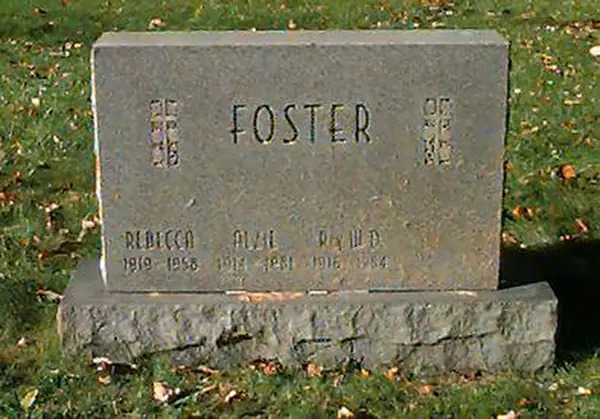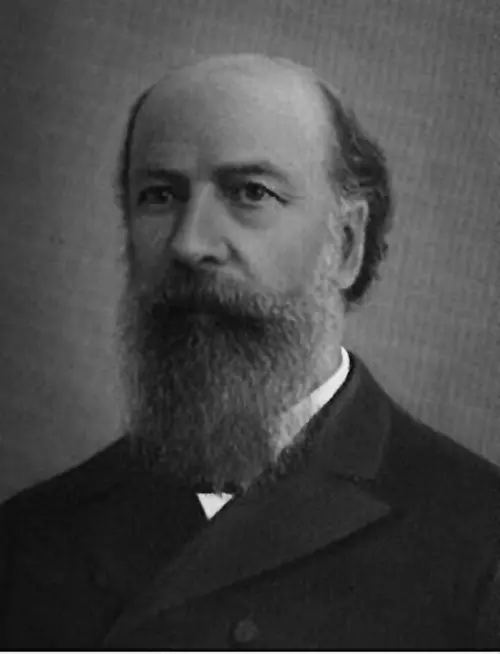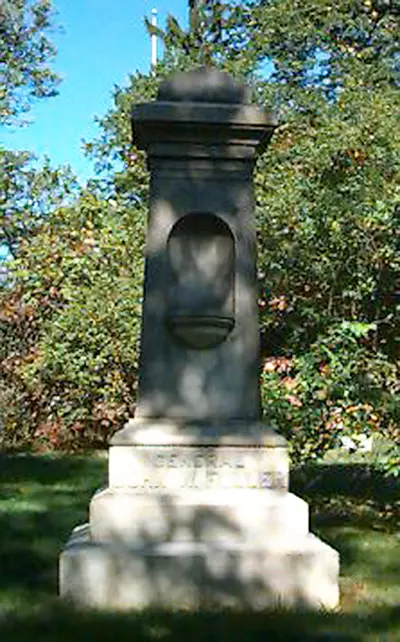Edwin F. Damschroder Sr. - Isaac Horning Detwiler - Henry Dodge - Charles C. Doolittle - John Hardy Doyle - John Felker - Stevens Warren Flower - George R. Ford - Albert V. Foster - John W. Fuller
Edwin F. Damschroder, Sr.
Edwin F. Damschroder Sr., was born in Elmore, Ohio, in 1884. As a youth he worked as a sales representative for the St. Francis Hat Company of Baltimore, Maryland. His sales district extended from Kansas City to the West Coast. In 1916 he came to Toledo and founded the Damschroder Clothing Company. In 1920 H.E. Berry became a partner and the company name was changed to Damschroder-Berry, Inc. The new company moved from St. Clair and Adams Streets to 311 Superior Street. In 1956 Berry retired and the company name was changed back to Damschroder Incorporated. Edwin F. Damschroder remained president of the company until his death in 1959.
Damschroder was married for fifty-three years to Bertha Damschroder. They had three sons and two daughters. Edwin F. Jr., served as the secretary-treasurer of his father's company, however, Damschroder's other children were never involved with the daily operation of the company. Damschroder had five grandchildren at the time of his death in July 1959 at St. Vincent's Hospital. He was 75 years old.("Edwin F. Damschroder, Sr.," Toledo Blade, 30 July 1959.) The Damschroder store still exists as the Damschroder Suit Connection.
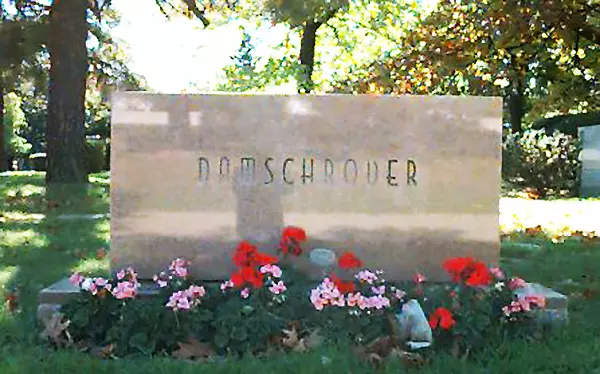 Edwin F. Damschroder, Sr.'s grave
Edwin F. Damschroder, Sr.'s grave
Isaac Horning Detwiler
Isaac Horning Detwiler was born on March 15, 1820 in Pennsylvania. Isaac was one of ten children whom his mother raised alone without the benefit of a father. He left his family at an early age to work on a farm. While on the farm he learned to mill grain. When he left the farm he became involved in the grain business and interested in milling flour. In 1865 he became a resident of Toledo and he continued in the grain business as part of the commission firm of Detwiler and Bashare.[Nevin O. Winter, A History of northwest Ohio, vol. 2 (Chicago and New York: The Lewis Publishing Co., 1917). 1105.] He married Hannah Yoder Knabb and they had four children, two of whom Abraham and George Detwiler, remained in Toledo.(Ibid.)
In 1872 Isaac started a new firm, I.H. Detwiler and Company, with his two sons, Abraham and George. The firm quickly assumed a leading position among real estate firms in Toledo.Ibid. The business was known for subdividion of land and thousands of homes were built on the lots that were put on the market by the Detwilers.[Harvey Scribner, Memoirs of Lucas County and the City of Toledo, vol.2. (Madison: Western Historical Association, 1910). 192.]
The two Detwiler projects that helped shape Toledo of were the additions made to Fitchland Avenue and those in East Toledo.George K. Detwiler Dies," Toledo Blade 11 January 1938. The Fitch 280 acre farm was bound by Bancroft and Dorr Streets, Detroit Avenue, and the old county fairgrounds. In this area lies the Ransom, Englewood and Fair Ground additions. The firm also completed the Virginia Street and Norwood additions.Winter, 1116. Isaac Detwiler helped found the Toledo Building and Loan Association and with the help of this Association many people in Toledo were able to purchase their own homes for the first time.Scribner, 192. Isaac Detwiler was one of the influential figures in the creation of the Toledo Loan Company, now the Toledo Savings Association. The Association was founded on January 1, 1885, and Issac Detwiler continued to be identified with it for the remainder of his life. He died on November 26, 1889.
After their father died, the George and Abraham continued to run their father's business. In September of 1925, George and Abraham announced that they would give the city 200 acres of land adjoining Bay View Park."George K. Detwiler Dies" This began a tradition that saw many prominent families donate land or former family estates to the city. The land that the two brothers gave to the city was later developed into a public golf course which was given the name Detwiler Park in the 1960s.Ibid. It was the first course designed by now famous golf architect Arthur Hills who has gone on to design over a hundred courses, many along Michigan's gold coast.Ibid.
George K. Detwiler was born on August 3, 1855 in Pennsylvania. In 1879 he graduated from Cornell University. After he graduated George became the president of his father's company. Abraham was made vice-president. George was a member of the Toledo Real Estate Board for more than 20 years and was also president for some time. He was a member of the Park Planning Commission as well as a member of the City Planning Commission. He died on January 10, 1938.
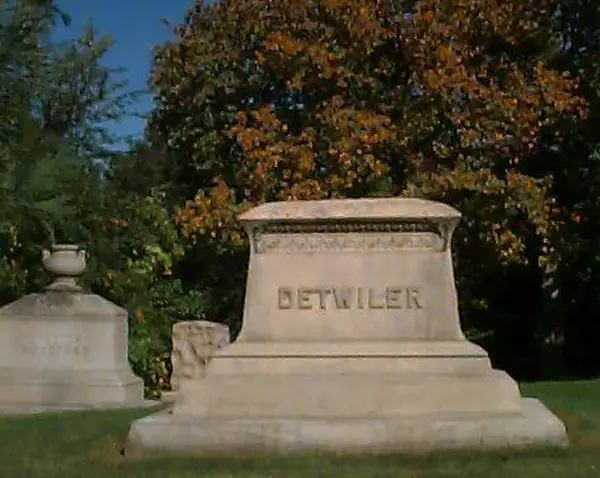 Isaac Horning Detwiler's grave
Isaac Horning Detwiler's grave
Henry Dodge
Henry Dodge was a native of Toledo, born on 27 December 1871. His parents, Frederick B. and Caroline (Perkins) Dodge, came to Toledo in 1861 when Henry's father became the principal of the first Toledo high school. His father later moved into the law profession. Henry's father died in 1893 and his mother died in 1911.
Henry was one of five children. He was schooled at the High School of Toledo and graduated in 1889. He then attended the University of Michigan where he specialized in electrical engineering, graduating in 1893. Once he had finished his education he returned to Toledo where he joined the engineering department of the Toledo White Lime Company. He eventually left this job to work in the engineering department of the Ohio Electric Car Company, where he stayed as general manager until 1915.
In 1915, Henry started his own business. He was president of the H.P. Dodge Engineering Company and the inventor of a number of electrical devices which he later patented. The Dodge Engineering Company was an immediate success in the manufacture of battery acid and electric batteries for cars. Henry was involved in the development of some important innovations, including the "Dodge Process" for hydrating lime which helped revolutionize the quick lime industry. He also invented a new process to manufacture storage battery plates which claimed to improve the life of the plate as well as lowering the cost.
Henry had a wide variety of business and social interests. He was the director of the Walding, Kinnan and Marvin Company of wholesale drugs. He was involved in the social clubs of the city. He was a member of the Toledo Yacht Club, the Toledo Commerce Club, the Maumee River Yacht Club, the Toledo Tennis and Toledo Country Clubs, as well as the American Institute of Electrical Engineers.
On September 25, 1896, Henry married Gertrude Marvin, the daughter of Henry Marvin who owned a Toledo druggist company. They had two children, Henry Marvin Dodge and Charleton M. Dodge (who later married a Baumgardner). Henry P. Dodge died on June 17, 1943 and is buried in Section 148A, Lot 42 at Woodlawn Cemetery.[John M. Killits, ed., Toledo and Lucas County, Ohio 1823-1923, vol. 3. (S.J. Clarke Publishing Company: Chicago & Toledo, 1923), 540-41. Killits was the only source found for Henry P. Dodge leaving 20 years unaccounted for in his life.]
Charles C. Doolittle
Charles C. Doolittle was born in Vermont. When he was four years old his family moved to Montreal, Canada. His father lost his property when Doolittle was aged fifteen and he was forced to quit school and find a job. Doolittle later moved to New York City where he achieved a measure of material success.
Before the Civil War Doolittle moved to Southeastern Michigan. He would became a Colonel in the 18th Michigan Volunteer Infantry that was formed out of Hillsdale and Lenawee Counties. During the Civil War he was promoted to Brigader General in recognition for his service. Doolittle attributed his success to "self reliance through industry, economy, and correct habits."[Clark Waggoner, ed., History of Toledo and Lucas County. (New York: Monsek, 1888), pp. 91, 226, 490, 825-26.]
During a potentially violent strike in July 1877, Doolittle became a member of the first ward of the Committee of Safety. The Committee was made up of eight wards, each composed of 20 men who enlisted other citizens to help keep order. In April of 1881, Doolittle helped to form and was the main cashier at the Merchants' National Bank of Toledo. He was an Elder at the Westminster Church of Toledo and also served as the President of the Toledo branch of the Society of the Army of the Potomac in 1887.
John H. Doyle
John Hardy Doyle was a prominent and respected lawyer, historian, and publisher, whom Toledo proudly boasted as one of its own. He was celebrated by the state of Ohio for his eminence. He was the youngest man to ever occupy the Supreme Court bench of Ohio and his professional reputation was well known throughout the mid-western territory. He was born in Monday Creek Township, Perry County on April 23, 1844 to Michael and Joanna (Brophy) Doyle, descendants of an ancient Irish family. They moved to Toledo in 1847 when John was three years old.
One of five children, John, went through Toledo public schools and attended, for a short while, Denison University. His devotion to and passion for law found him studying the legal profession giving particular attention to the principles of jurisprudence in Toledo. Noted for his sterling qualities, he was admitted as a partner to a legal firm run by his former professor, Edward Bissell. He remained with the firm for thirteen years until he was thirty-four. He then secured a position on the common pleas bench in Lucas County. Mr. Doyle earned a reputation of honesty and gained a large clientele. He was associated with important cases of litigation in early Toledo history.
He was recommended for a Court of Common Pleas judgeship by unanimous vote of the Republicans who dominated the Lucas County Bar Association at the time. He was elected by a democratic majority of 800 and was one of the few Republicans to serve in that election. In 1883, he was chosen to serve as a judge on the Ohio Supreme Court, the youngest member elected to such a position. He is still known as one of the most profound and brilliant jurists Ohio has ever produced.
After his retirement from the Supreme Court, he returned to Toledo and continued in private practice as a senior partner in the law firm of Doyle, Scott, and Lewis. He was always in demand and tried most of the important cases in the city of Toledo during that time.
Judge Doyle married Miss Alice Fuller Skinner on October 6, 1886. Mrs. Doyle, whose ancestor Oliver Wolcott was a signer of the Declaration of Independence and whose father was a veteran of the Civil War, was active socially in Toledo and a prominent member of the Daughters of the American Revolution (DAR). The couple had six children.
John Doyle was a member of the First Congregational Church of Toledo and served as President of their Board of Trustees, retaining the title of trustee emeritus until his death. He was also interested in literature and was a prolific writer. He organized the literary society known as the New Century Club. Of particular interest to him was the history of northwestern Ohio, a subject about which he wrote. His interest in history spurred him to organize the Historical Society of Northwestern Ohio of which he also served as president. The only source of literary acclaim he received was his book A Story of Early Toledo which related early pioneer history and historical facts relevant to this part of the state. The Commerce Club News published this serial throughout 1919.
Doyle was a generous benefactor and a sought-after speaker. Socially, he was involved in numerous clubs which included: the Toledo Club, the Lawyers Club, Toledo Commerce and Country Clubs, Ohio Society of New York, and the Toledo Yacht Club. He encouraged business to settle in Toledo and increase the wealth and prosperity of the city. John Hardy Doyle died on March 24, 1919 at the age of 75. He is interred in a mausoleum along the lake.(Toledo Biography Scrapbook (FISH-FORN), Local History Room, Toledo Lucas County Public Library.)
John Felker
John Felker was born on November 23, 1854 in Fort Wayne Indiana He lived in Indiana until 1875 when he emigrated to Toledo. Once in Toledo he worked with A.T. Babbit & Co., a hat-making company. In 1876 he left Babbit's to establish his own haberdashery company.
In 1882 radically changed his profession and founded "Felkers" food market. He remained active in this business until a broken hip forced his retirement in 1921. In 1927, Felker expanded the business and moved it to Ashland Avenue. He then assisted his son Herbert Felker in the operation of the family business until 1932.
John Felker was married to Mary C. Kohne who died in April, 1931. They had a son, Herbert, who as noted above, took over the family business in 1932. On May 13, 1933 he was married for a second time, this time to Esther Amstutz with whom he had a daughter, Dorie Mae, born on February 25, 1925.
Not only was he active in the business community, but he was also actively involved in the social life of Toledo. He was a member of the Ashland Avenue Baptist Church, a trustee of Woodlawn cemetery for 45 years, a member of the Toledo Food Distributors Association, the Ohio State Grocers Association, the National Grocers Association, the Toledo Chamber of Commerce, the Toledo Club, and the Masons. Jim Felker died April 9, 1946. [Toledo Biographical Scrapbook (Fen-fist) Local History Room, Toledo Lucas County Public Library. Randolph C. Downes, ed., A History of Lake Shore Ohio: Family and Personal History, vol. 3 (New York: Lewis Historical Publishing Co., 1952, 363-364.]
Stevens Warren Flower
Stevens Warren Flower, the man who gave his name to Toledo's Flower Hospital, has been called "one of Toledo's noblest citizens."[Nevin Winter, A History of Northwest Ohio, vol 1 (Chicago & New York: Lew's Publishing Company, 1917), 1392]. He was born in Clayton, New York on August 21, 1832, and was the son of Joseph and Amy Stevens Flower. When he was two years old, his father died. Five years later his mother married Augustus Ford, a Master in the U.S. Navy. At that time the family moved to Sackett's Harbor, New York.[Harvey Scribner, Memoirs of Lucas County and the City of Toledo, vol, 2 (Madison: Western Historical Association, 1910), 466.]
On September 12, 1862 Flower joined the Union Army as a First Lieutenant in Company H of the Tenth New York heavy artillery.Winter, 1393. According to the (Toledo Biography Scrapbook), he joined the union Army in 1861. He saw combat many times, including Cold Harbor, Petersburg, and Richmond. His service record was exemplary and he became the quartermaster of his unit.Winter, 1393. He served as quartermaster till the end of the war. General Sherman and General Sheridan received supplies from Flower as they passed through Petersburg near the end of the war. Sheridan complimented Flower for the promptness and efficiency he demonstrated in his position. He was recommended for a promotion by General Grant to Assistant Quartermaster General after the fall of Richmond, Virginia. Sadly Flower was forgotten in the wake of Lee's surrender and the assassination of President Lincoln.
Immediately following the war, Stevens Flower moved to Ohio and in September 1865 he married Frances B. Reynolds, the daughter of George Reynolds. In Spring 1866 he bought an interest in the Reynolds flour mill in Maumee. In July, Frances Reynolds became ill and died in December. On October 8, 1874, Flower remarried Ellen Burge and they moved from Maumee to Toledo. She died in April of 1903.(Scribner, p. 469.)
In the Spring of 1866, Flower bought an interest in Reynolds Flour Mill in Maumee. About two years later, the Commission House of George W. Reynolds & Co. was established. The mill was shut down in 1873.Ibid., 466. At that time, Flower became the general manager of the Commission House which dealt in seeds, particularly clover seeds. In 1876, with the retirement of George Reynolds, he took over that business and renamed it S.W. Flower & Co.[Toledo Biographical Scrapbook. Local History Room. Toledo-Lucas County Public Library.]
Flower belonged to several social organizations including the Masons, Sons of the American Revolution, and the Toledo Produce Exchange. He also served one term as President of the Produce Exchange. He was a very religious man who taught Sunday school and attended several different churches during his life.
After Flower's death on November 13, 1908 the land at Cherry Street and Collingwood Blvd. was donated to build the Flower Hospital. It is this gift of charity for which Stephens Flower was always remembered.(Ibid)
George R. Ford
George R. Ford, a manufacturer and financier, succeeded his father, Edward Ford, as treasurer and general manager of the Toledo branch of the Edward Ford Plate Glass Company. It was the largest plate glass works in the world, and was located in Rossford, Ohio.[Harvey Scribner, ed., Memoirs of Lucas County and the City of Toledo, vol. 2 (Madison, Wisconsin: Western Historical Association, 1910), 186].
Ford was born July 25, 1882, at Creighton in Allegheny County, Pennsylvania, the son of Edward and Carrie J. (Ross) Ford. Carrie was born in Zanesville, Ohio on June 28, 1853. She was the daughter of George S. Ross and Laura Hampton. Carrie married Edward Ford on 8 October 1872 and it was not until 1898 that the two moved to Toledo. Edward bought a large tract of farmland and on this he established the Edward Ford Plate Glass Company and developed the town of Rossford. Carrie died in 1936 was buried at Woodlawn Cemetery.(Ibid).
Ford was first educated in Allegheny County, then went to Detroit to attend a manual training school. When he left school he started work at his father's plate glass company where he spent four years learning the skills of the trade for making glass. Soon after he began working at the company he became the treasurer and general manager. When his father died in 1920, Ford became president of the company.
In 1907, Ford married Grace Williams Miller of Detroit. Her father was involved in the D.M. Ferry Seed Company and the Royal Manufacturing Company. Grace had attended and graduated from Miss Liggett's School of Detroit as well as Miss Morgan's boarding school in New York City. The Fords had three children, George R., Jr. (1909), Grace (1910), and Felia (1920).[John M. Klllits, ed., Toledo and Lucas County, Ohio 1623-1923, vol. 2 (Chicago & Toledo: The S.J. Clarke Publishing Company, 1923), 274-77.]
George R. Ford was involved in banking, acting as president and director of the Rossford Savings Bank, and director of the First National Bank of Toledo, Summit Trust Company, and the Michigan Alkali Company. He was also stockholder in the Atwood Automobile Company which was located on Madison Avenue in Toledo.
George and his brother-in-law, W.W. Knight, purchased 75 acres of land overlooking the Maumee River in Oregon Township. Here they built two summer houses (Scribner, 186). The home on East River Road was the largest in Northwest Ohio at the time, containing 57 rooms. The G.R. Ford mansion was built in 1923 by A. Bentley and Sons Company. It had a ballroom in the basement, a two-story pipe organ, caretakers house, gatekeepers house, a guest cottage, 11 bathrooms, and 13 fireplaces. Upon his death on 2 September 1938, George's estate was valued at $4,585,384.(Toledo Biography Scrapbook, George Ross Ford, Local History Room, Toledo-Lucas County Public Library.)
Alber V. Foster
Albert V. Foster was the president and director of his own investment firm, A.V. Foster and Co. Foster was born on a farm in Hillsdale County in about 1880. He attended high school in Hudson and then Cleary's Business College in Ypsilanti, Michigan. He started his career in June 1899 at a private bank in Morenci, Michigan. Two years later Foster helped with the bank's transition to the First National Bank of Morenci. In 1902 he was made a cashier of the bank. He held that position until he left in 1912 to join Spitzer-Rorick & Co. The members of the Spitzer and Rorick firm were municipal securities dealers. In 1935 Foster resigned and started A.V. Foster and Company. Albert Foster was also vice-president and director of the Pemberton Cadillac Co., and the Hudson State Savings Bank. He was also a director of the Parker Rustproof Co."A.V. Foster: Founder, President of Investment Firm," Toledo Blade 4 January 1950.
Foster married Leila Estel Rorick in 1903. They became the parents of Cordelia, Oscar, and Robert. Albert Foster died on January 4, 1950 after an illness of seven months. He had achieved success in his career and left an estate valued at over $125,000,000."Foster Estate is Valued in Excess of $125,000,000," (Toledo Blade 12 January 1950). Leila Rorick Foster died in October 1980 at the age of 100. At the time she was the oldest living graduate of Adrian College.("Leila Foster," Toledo Blade 3 October 1980.)
Albert and Leila's son, Oscar, also became a successful businessman. He was born in Morenci, Michigan c. 1907. He graduated from Yale University in 1928. He was employed at Snyder, Wilson & Co and eventually became a senior partner at the firm but left to form his own company. He founded the brokerage firm Foster Bros., Weber and Co. When Foster Bros. merged with Bache Halsey Stuart Shields, Inc., he became a member of that firm. It was one of the nation's largest brokerage houses. Later that company became Prudential Bache securities. Oscar Foster was on the Toledo and Riverside Hospital Boards, the Rotary Club, the Toledo Country Club and the Toledo Society for the Handicapped. He retired from his business in 1988 and died in August of that year."(Oscar Rorick Foster," Toledo Blade 5 August 1988.)
John W. Fuller
John W. Fuller was born on July 28, 1826 in Cambridge, England. Fuller was the son of a Baptist minister and was educated at home by his father who was a graduate of Cambridge University. In 1833, Fuller and his father left England and settled in Utica, New York. In the early 1840s Fuller entered the book selling and publishing business, becoming one of the leading businessmen of the city. On September 2, 1851, Fuller married Anna B. Rathburn who was the daughter of Josiah Rathburn. Following the destruction of his business in 1859 by fire, Fuller moved to Toledo and once again entered the publishing business.[Harvey Scribner, ed., Memoirs of Lucas County and the City of Toledo, vol. 2 (Madison, Wisconsin: Western Historical Association, 1910), 40].
After the outbreak of the Civil War in 1861, Fuller was appointed as chief-of-staff to Brigadier General Charles W. Hill. Upon his appointment, Fuller was sent to Grafton, West Virginia where he became engaged in drilling recruits for military service. Impressed by his ardor and zeal for the military, Rathburn's superior, General T.J. Cram wrote a letter to Adjutant-General C.P. Buckingham, recommending that Fuller be promoted as "the colonel of the next Ohio regiment sent to the field." General Cram's advice was needed, and on August 18, 1861, the Twenty-seventh Ohio Infantry, headed by Colonel John W. Fuller, was mustered into the U.S. Army.(Ibid.) On August 20, the Twenty-seventh Infantry disembarked for St. Louis, Missouri. In the late summer and fall of the same year, Fuller's troops saw their first action when they were engaged in the Missouri campaign against Confederate General Sterling Price.[James M. McPherson, Ordeal by Fire: The Civil War and Reconstruction (New York: McGraw-Hill, 1982), 158.]
Following the end of hostilities in Missouri that winter, Colonel Fuller's troops joined Federal forces under General John Pope. Under Pope's command, the Twenty-Seventh Ohio infantry took part in Pope's successful campaign to subdue rebel forces on Island No. 10 on the Mississippi River. Succeeding in knocking out Island No. 10, Fuller was placed in command of the "Ohio Brigade." The brigade, which consisted of the Twenty-seventh, Thirty-ninth, Forty-third and Sixty-third Ohio regiments saw action in the battle of Iuka in September 1862.(Ibid.) In October of the same year, the brigade once again saw action in the battle of Corinth. For the valatorious action of the brigade at Corinth, Fuller was personally thanked by the Union commander, General William S. Rosencrans.(Scribner, p.41).
Following the brigade's defeat of Confederate forces at the battle of Parker's Cross-Roads in Tennessee, Fuller was put in command of the Union post at Memphis where he and the brigade remained until October, 1863. During the winter of 1863-64 the Ohio Brigade remained relatively inactive. The following spring however, the brigade once again found itself in action, this time in the Eastern Theater of the war, seeing combat at Dallas, Snake Gap Creek, Resaca, Kenesaw Mountain and Nickajack Creek. In July, the brigade was one of the first units to see action in the Battle of Atlanta. During the battle, Fuller ordered the brigade to execute a change of front in order to repel an enemy attack from the rear. At that moment, Fuller, heedless of the danger of enemy gunfire, snatched the brigade flag and lead the charge against the enemy approaching from the rear.Ibid. For his valatorious actions, Fuller was promoted to brigadier-general.
Following the successful Atlanta campaign, the brigade, having been absorbed by the Seventeenth corps under the overall command of General Blair, participated in General William Tecumseh Sherman's famous "March to the Sea." After the fall of Savannah, Georgia in December of 1864,(McPherson, p.463.) Fuller's men took part in the campaign in the Carolinas, and following the fall of Richmond, Virginia, marched with General Sherman's victorious command from that city to Washington, DC.(Scribner, p.41).
In light of the meritorious services of the Ohio Brigade throughout the Civil War, the unit was mustered out in March 1865, one month before the conflict was over. General Fuller was discharged from the Army as a major-general. In August he resigned his commission and returned to Toledo(Ibid). where he entered public office as the collector of the Port of Toledo in 1874, an office which he held until 1881. In addition to his public duties, Fuller once again entered the business world as one of the owners of Fuller, Childs & Co., a wholesale boot and shoe warehouse. He also became the director of the Merchant's National Bank and the Toledo Moulding Company.(Ibid, p.42). He died in Toledo on March 12, 1891.
Rathburn Fuller, the second son of General John B. Fuller, was born in Toledo in 1857. Rathburn received his primary and secondary education in the public schools of the city.("Rathburn Funeral Rites Saturday," Toledo Blade 17 December 1937). Upon completing his high school studies, Rathburn attended law school at the University of Michigan. Two Years into his program, however, he had to end his matriculation due to economic hardships. Following his abrupt change of plans, Rathburn returned to Toledo. He found employment with the firm of Haynes Potter & Beckwith and was admitted to the bar in 1879.(Ibid.)
Shortly after starting with Haynes, Potter, and Beckwith, Fuller married Katherine Grout of Detroit, Michigan.Exact date unknown. In 1881, Rathburn started the law firm of Collings & Fuller where he practiced law until 1888 and also served as deputy clerk for the U.S. district court and then as U.S. commissioner.("Rathburn Funeral Rites Saturday."); Following his departure from Collings & Fuller, Rathburn added his name to the law firm of Swayne, Hayes & Tyler. After the deaths of Mr. Swayne and Mr. Birchard, Fuller continued to operate the office under his own name.(Ibid.)
In addition to his legal affiliations with the American and Toledo Bar Associations, Rathburn was active in several different organizations including the Ohio Society of New York, the Toledo Elks, the Toledo Club, the Chamber of Commerce and the Inverness Club. Fuller also had a myriad of financial concerns, holding large amounts of stock in the Toledo Trust Co., the National Bank of Toledo, Toledo Edison, Bostwick Braun, Toledo Scale and Libbey Owens Ford. He was also a trustee of the Toledo Museum of Art, the Edward Drummond Libbey Trust and Vice President of the Toledo Zoological Society.(Ibid.)
Fuller retired from professional life in 1907 and died at the age of 80 of a heart attack on December 16, 1937.("Noted Toledo Lawyer Dies," Toledo Times 17 December 1937). Upon his death in December 1937, Rathburn Fuller left the majority of his estate, approximately $150,000 to his wife Katherine.("Institutions Are Helped by Attorney," Toledo Times 21 December 1937). Mrs. Fuller, who died at the age of 93 in 1953, used the bulk of her inheritance for philanthropic purposes, donating large amounts of money to the Toledo Nurses Association, the Toledo Museum of Art, the Toledo Zoological Society and the Toledo Hospital.("K.G. Fuller: Attorney's Widow Was Philanthropist," Toledo Blade, 2 December 1953.)

